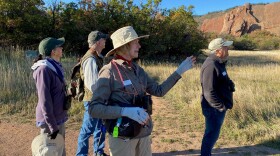The warming climate has led to some subtle changes in the size and wings of birds, according to new analysis from researchers at the University of Michigan.
The research – published this month in the Proceedings of the National Academy of Sciences – relied on data from two papers on migrating birds in Chicago and non-migrating birds in the Amazon. Combined, the analysis draws on data from more than 86,000 birds and nearly 130 species collected in the Western hemisphere over the past 40 years.
Researchers found that despite geographical differences, the sets of birds were getting smaller and longer-winged as temperatures rose.
“In the field of ecology, it is extraordinarily rare to find something that's consistent across that many species,” said Brian Weeks, an evolutionary ecologist from the University of Michigan who worked on the study. “So it really seemed like kind of a fundamental pattern that we had stumbled on.”
Some bird experts theorize that this could be due to Bergmann’s Rule, a zoology concept that birds in warm climates tend to be smaller to avoid overheating.
But the researchers identified another pattern: bodies of smaller bird species were responding more quickly to climate change than larger species. This was true even when researchers controlled for differences in generation length between species.
Weeks believes consistent adaptations in body size to climate change will affect the population sizes and fitness of a species. But his research does not explain what those effects are. And it’s not clear why smaller birds are changing faster.
“It could be that smaller species are better able to adapt to a changing climate,” Weeks said. “It could be that smaller species are more impacted by a changing climate, and so they're having to adapt more.”
Despite this, Weeks said species in hot and dry climates – like the Southwest – are becoming increasingly stressed. “There's a lot of evidence that…the ability of species to track changes in climate through changes in their size seems to be an important predictor of how well their populations do.”
Through more research, Weeks hopes to understand the reasons behind these changes, so efforts to save species and their habitats can be prioritized.
“There are still incredible mysteries to be solved and incredible patterns to be found and incredible aspects of nature that we don't understand that have massive implications for human health and well-being,” he said. “The only way to really understand that is through consistent long-term investment in the natural sciences and things like natural history museums and long term ecological research.”
This story was produced by the Mountain West News Bureau, a collaboration between Wyoming Public Media, Nevada Public Radio, Boise State Public Radio in Idaho, KUNR in Nevada, the O'Connor Center for the Rocky Mountain West in Montana, KUNC in Colorado, KUNM in New Mexico, with support from affiliate stations across the region. Funding for the Mountain West News Bureau is provided in part by the Corporation for Public Broadcasting.





